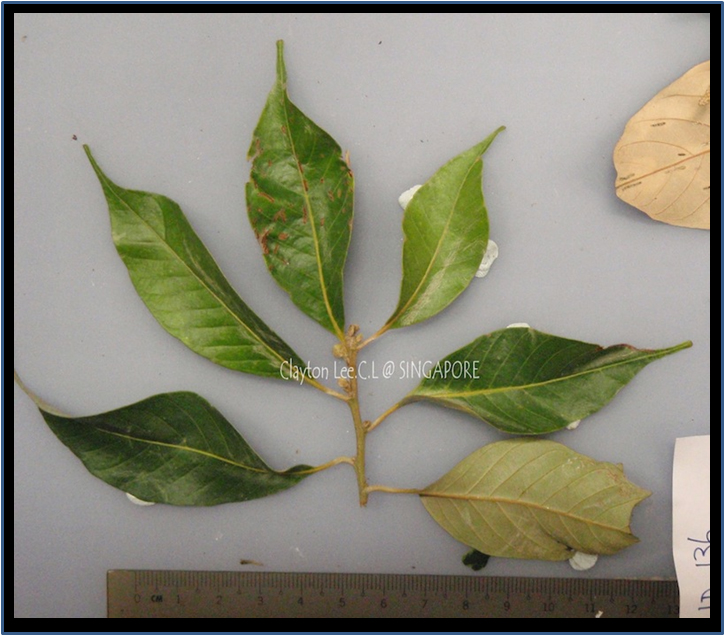Lithocarpus ewyckii (Korth.) Rehder, J. Arnold Arbor. 10: 132 (1929)
Named after D.J. van Ewijck van Oostbroek en de Bilt [1786-1858], Secretary General of the Department of Education, Industry and Colonies and as such a supporter of Tropical Botany in Indonesia.Synonyms
Cyclobalanus ewyckii (Korth.) Oerst.
Lithocarpus pseudolamponga A.Camus
Pasania ewyckii (Korth.) Gamble
Pasania lamponga (Miq.) Gamble var. ewyckioides Gamble
Quercus ewyckii Korth.
Quercus ewyckii var. latifolia King ex Hook.f.
Quercus lamponga var. ewyckioides Gamble
Synaedrys ewyckii (Korth.) Koidz.
Diagnostics
Large trees up to ca. 50 m tall and 90 cm diameter. Stipules present.
Leaves alternate with inconspicuously swollen base of petiole, leaf blade ovate-elliptic, hairy below,
pinnately veined with many secondary veins, lower surface shiny brown-yellowish. Male inflorescences in
spikes of up to 18 cm long, female inflorescences slightly shorter. Fruit a nut with a diameter of ca. 2.5
cm that is less than half covered by the cupule. Cupule with spiral ridges.
Description
Tree up to 50 m tall, 90 cm diameter. Bark smooth or scaly, greyish brown to reddish
brown; inner bark fibrous, brownish. Sapwood brownish. Twigs subglabrous, sparsely
lenticellate or smooth. Stipules linear, 4-5 x 1 mm. Leaves thin-coriaceous, subglabrous
above, sparsely appressed yellowish tomentose with simple hairs below; elliptic or ovate,
(6-)9.5-13(-15) x (2.5-)3-6(-7) cm, base rounded or obtuse, margin not undulate, revolute,
apex bluntly to sharply acuminate, acumen (5-)10-20 mm long; midrib faintly raised
on both surfaces, stronger below; lateral veins thin, (12-)13-15(-16) pairs, dense, flat
or sometimes obscure above, raised below, disappearing or faintly joining near the leaf
margin, forming an angle of 45-60 degrees with the midrib; intercostal venation scalariform,
dense, obscure above, prominent below; petiole 5-15(-24) mm long. Inflorescences male,
androgynous or mixed. Male inflorescences 10-18 cm long; bracts and bracteoles ovate,
c. 0.5 x 0.3 mm. Male flowers solitary or in clusters of 2-3 along the rachis; perianth
lobes acute, c. 1.2 x 1 mm; stamen filaments 2-3 mm long; pistillode globose, c. 0.7
mm diameter. Androgynous or mixed inflorescences 5-10 cm long; bracts and bracteoles
ovate, 1-1.2 x 0.5-0.6 mm. Female flowers solitary along the rachis; perianth lobes
acute, c. 0.7 x 0.5 mm; staminodes 12; styles conical, slightly recurved, c. 1 mm long.
Cupules solitary along the rachis, with stalk 5-10 mm long, cup-shaped, 0.4-1 x 2-
2.5 cm, sparsely tomentose, lamellate; wall woody, thick, sparsely hairy, enclosing less
than half of the acorn; lamellae distinct, edge entire, set in 6-7 regular lines. Acorns
conical to ovoid, 1.7-2.3 x 1.5-2.5 cm, most part exserted, glabrous, brownish; base
rounded, apex abruptly acute; scar deeply concave, 1-1.5 cm diameter; wall bony, thick,
most part free from the cupule. [from Tree Flora of Sabah and Sarawak]
Ecology
In primary hill mixed dipterocarp forest, including kerangas forest, to montane
forest, at 200ĘC2000 m altitude, on sandy loam and clay soils.
Uses
Distribution
Peninsular Malaysia, Sumatra and Borneo.
Local names
Borneo: Salad repak (Kelabit), Ta'alan (Punan).
